When the Land was Settled
I live at the edge of the rain forest, a delicate land with sweeping glaciers behind me, thunderous waterfalls and rivers, and the long, yawning arm of the Cook Inlet, its gray waters booming in then ebbing, leaving thick silt-laden mudflats. The Matanuska Valley spreads below me, weaving north, lush with black, loamy soil and sunlit havens. This forest begins its journey on the Washington Coast, wanders up Canada, nestled between the coast and the Rockies, which turn into the Chugach once you reach Alaska, and branch off to include the Panhandle.
We have an average two hundred seventy seven days of precipitation in my rain forest home. The first settlers who came here with their shrubs, their trees, the vegetables they hoped to grow, found it very difficult to grow much of anything. Carrots, they discovered, grew well, as did potatoes, snap beans and cabbages. In fact, it was rather astonishing how well cabbage could grow. It wasn’t long before people were growing forty to fifty pound cabbages that were nothing more than runners-up in the state fair cabbage growing contest.
Their mammoth sized ability was accredited to three things, the extremely nutritious soil, the twenty four hours of summer sunlight, and the consistent rains. Other cold weather vegetables were tried, with varying degrees of success, and the list of things you could grow and eat in Alaskan soil became longer. Rhubarb and strawberries were highly successful and soon became a fruit staple for the winter months, along with jellied indigenous berries.
Nearly every indigenous plant in rain forest Alaska is edible. There are two poisonous ones; water hemlock and wild celery. Even some of the most annoying plants have beneficial qualities. The stinging nettle, which can cause rashes almost as bad as poison ivy when in contact with the skin, can be harvested and dried, contains niacin, and adds a delicious flavor and extra fiber to your foods. The devil’s club, well named for its thick thorns on both the stems and the leaves, unpleasant even to the indiscriminate tastes of goats, and with bright red, poisonous berries in the fall, is actually a member of the ginseng family. Although the roots only contain one tenth the medicinal properties of ginseng, they can still be boiled and made into a rejuvenating tea.
Another tea that early pioneers began making for their spring tonic, was the plant they called Labrador Tea, also known as leatherleaf. It’s properties kept them vigorous enough to ward off the yearly summer transits of colds and viruses. They also discovered that the curled, tender shoots of the fennel fern, which grows to a size reminiscent of a primordial forest in the summer, was a delicious dietary supplement. The fireweed, which grows over six feet tall and is so aggressive you have to beat it back from your front door, has all the vitamins and properties of spinach. A type of very spindly willow with salty tasting stems and branches, contains natural aspirin.
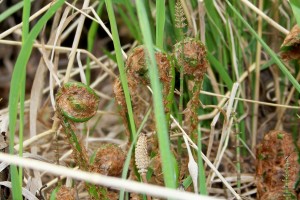
The variety of wild berries in the Alaskan rain forest are astonishing. Raspberries, high and low bush cranberries, salmon berries, crow berries, currents, high and low bush blueberries and rosehips grow in abundance, each species flourishing in its favored location.
An Era of Change
There wasn’t a great deal of variety to the early Alaskan diet, but it was healthy. Depending largely on the indigenous plants, dried staples, fish and game, they were able to maintain robust, thriving homes, even if it wasn’t such a robust economy. Not all their efforts to transplant bushes and shrubs from their home states were fruitless. Douglas Firs, mountain ash, and honey suckle bushes slowly took root, as did crab apple trees and lodge pole pines.
The slow transition brought new astonishment. Earthworms, transplanted with the soil brought in with the non-native shrubs, found refuge through the winter and slowly formed new colonies. Where the soil had been cleared and exposed to the sun, the perma-frost began to drop from just a few inches, to as far as a foot or two below the surface. Lilac bushes, May Day trees, Canadian cherries, that had once shrunk and withered in their contact with the permanently frozen sub-surface, found room to stretch their roots and multiply. The Alaskan tomato, once doomed for failure, became the epitome of success in Alaskan agriculture. Sweet apples began to bloom and drop their fruits.
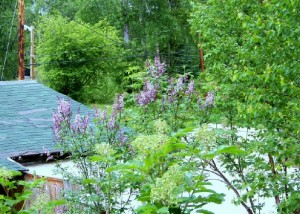
Even the indigenous trees were affected. Because of their shallow root system, the trees in the north-western edge of the rain forest did not grow very tall. The frigid winds snapped their tops and knocked the taller trees over. The warmer soil allowed them to grow so tall that even people living no more than a mile or so from the Cook Inlet, had to climb halfway up the tree line to get a view of the sluggishly moving water; a view that had once been taken as much for granted as watching the chick-a-dees flitting past your window. The warming trends brought a lushness to the edge of the rain forest that had not previously existed.
The changes brought both welcome and unwelcome migrations. Honey bees, which previously had been unable to survive, were imported by bee keepers and thrived quite well in the milder climate. The first hummingbird to migrate this far north, in 1990, astonished biologists so much it was arranged to have the bird captured and sent back to its southern habitat before winter hit. Since then, hummingbirds have been spotted on a regular basis each summer in Anchorage.
Trumpeter swans and Canadian snow geese, whose numbers had once been threatened, found comfortable summer homes in the warming Alaskan rain forest. The tiny Sitka deer, once reserved to the Panhandle Islands, are slowly finding their way to the mainland as the temperatures warm more to their tastes.
A drawback has been hitch-hiking insects that also have also been able to survive. Although many of the standard pests, like cockroaches, ticks and fleas; introduced through suitcases and airborne pets; were not able to survive the winters, a very nasty spider called the brown recluse, did. Until the brown recluse managed to take up official permanent residence, Alaska had no poisonous spiders.
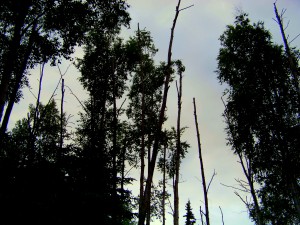
Ten years ago, the spruce beetle ravaged the Cook Inlet’s spruce, leaving thousands of acres of dead standing trees. This migrating beetle had never come this far north before as the climate had always discouraged it, but now it had found a lush, thriving rain forest. A few years ago, huge stands of birch trees died from a worm infestation, also introduced by the changing climate. Although the devastation wasn’t quite as great as the spruce beetle kill, which decimated ninety percent of the spruce, many of the dead birch from the rampaging insects are still standing.
Modern Perspective
Although the devastation stunned us, nature has a way of quickly replenishing her rain forest. The new spruce that have gone up in the wake of beetle destruction, are fuller, thicker, more deeply green than their parents had been. The surviving birch spread their branches more comfortably in their added space. It is a rain forest that adjusts quickly to change for the changes only add to its ability to support life.
Its indigenous plants are some of the hardiest and fastest growing in the world. A stalk of grass can push itself through a crack in fresh pavement within a matter of weeks. Our soil is fertile, black as loam, heavy with water. While the glaciers melt or shift south-east, they expose new virgin soil that continues to be watered by the massive ice fields behind us. We have the potential to become one of the world’s bread baskets; or do we?
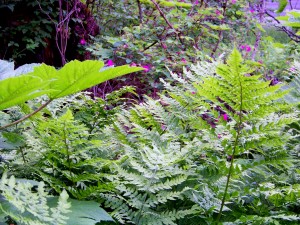
The Matanuska Valley, first settled by farmers, and the fore-runner of Alaskan agricultural technology, seems to have abandoned a large part of its dream to become an independent food supply for Alaskans. Producing farms have sold out to a housing industry that went on a rampage of pre-fab homes, to strip malls, hotels, restaurants and souvenir stores. Giant highways laid waste to the farm land and marshes to accommodate for the one million visitors the valley hoped to see each summer.
The Department of Transportation hasn’t taken a minute to examine their impact on global warming. While the black top superheats the soil, miles of wetlands are changed into shallow marshes, and natural marshes dry up, ruining the habitat of water fowl, tiny frogs, trout and grayling. In clearing a row of birch, they destroy the entire infrastructure for a system as the birch, like the aspen, have interconnecting roots that support each other. You cannot kill one healthy birch, without several others going down.
As a food supplier, much of the Matanuska Valley is being wasted in the preparation for another population explosion and rejuvenated tourism industry that shows no immediate indication of returning. The revenue the legislative committee is pinning its hopes on is a natural gas pipeline. One hundred million dollars has already been placed with a Canadian based firm for incentive monies. The problems involved are multiple, especially since Alaskans have good memory. The proposal was to run a line adjacent with the existing oil pipeline; a line so so corroded and lacking in upkeep, it has sprung numerous leaks throughout the last ten years. It was decided this couldn’t be done without considerable cost. The proposal would leave the Alaskan people dependent on just one energy and one avenue for generating income, just as the oil companies had done. Early experiences with natural gas companies had resulted in an attempt to remove the sub-surface rights of home owners. The existing gas companies, that promised its customers cheap energy, began blessedly enough, with very cheap prices, although in recent years they have spiked their rates so high, there is no difference between paying for natural gas or electricity for heating.
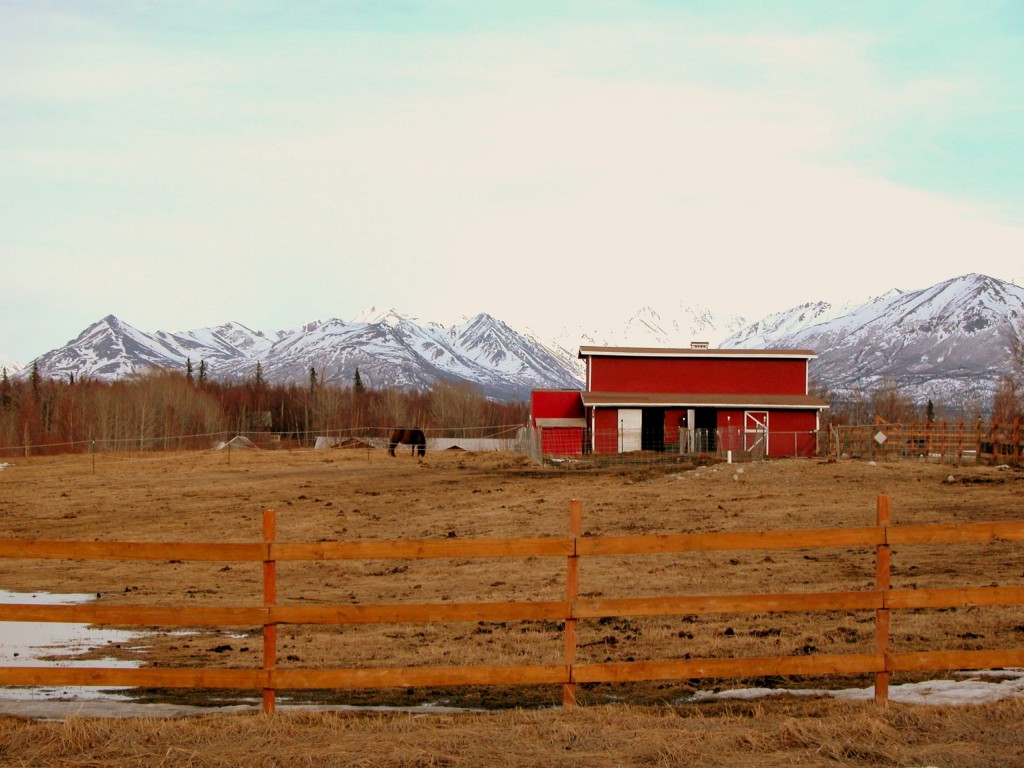
Senator Mark Begich claims Alaska has the opportunity to lead the world as a major supplier of energy. His main anxiety is in making sure the other countries of the world will not interfere with his energy plans, somehow managing to imply that the US was never the culprit in shooting down environmental controls. There is absolutely no record, however, of Begich going on the band wagon to support Iceland when it was the leader of alternative energy, with resources much the same as our own. Iceland’s current economic failure can’t exactly be blamed on cheap energy. It had everything to do with failed banking enterprise, but because they went bankrupt, it’s easy to dismiss their energy policy as a failure.
Despite the recent oil spill on the Mexico Gulf Coast, Senator Begich still supports off shore drilling in the Beaufort and Chukchi Seas. Like the Superior Judge who decided just because one off shore rig blew didn’t mean others well, he believes Alaska should take the gamble. Nor is he overly concerned about the environmental impact an enormous open pit mine would make on the marine life in the Bristol Bay if Northern Dynasty has its way and the Pebbles mineral extraction mine is constructed.
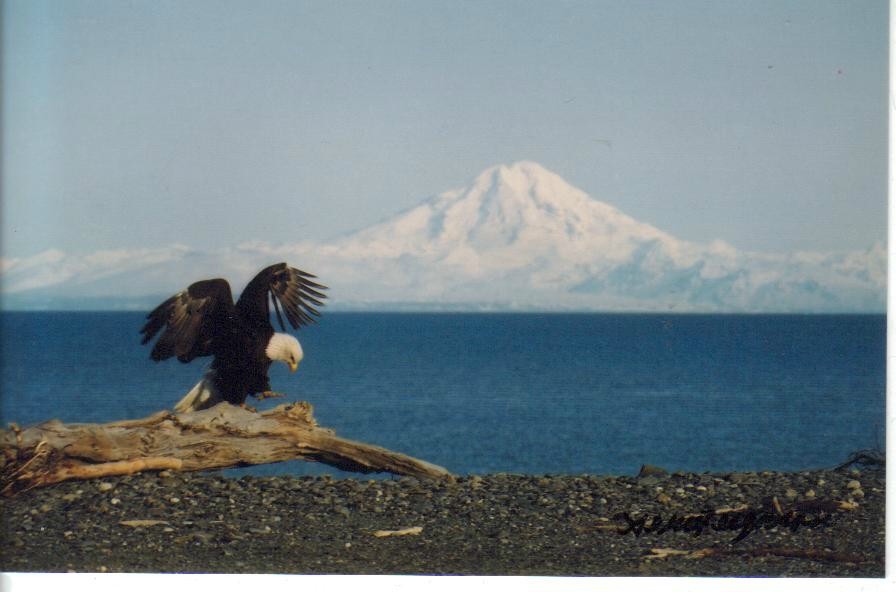
Alaska doesn’t need the archaic industry of oil and gas exploitation. It has numerous waterfalls for accessing hydrogen. It has hot springs and volcanoes offering their thermonuclear resources. It has voracious winds and powerful tides, all of which can be harnessed. Alaska can and should rely on its natural, renewable resources for energy.
The world can and should rely on its renewable resources for energy. There are natural gas deposits everywhere and the areas that have it in abundance are just as eager to develop it as Alaska. One monopoly over a non-renewable resource doesn’t cancel out another. It’s only swapping kings.
Alaska should not imagine it can attain to leadership by lowering its Clean Water standards to accommodate large scale mining. The Bristol Bay, at the mouth of the Cook Inlet is a pristine eco-system, harboring shrimp, salmon, whales, puffins, eagles, seals, sea lions in its waters, with beavers, moose, bears, wolverines, foxes and wolves along its shoreline. The leach field, filled with mercury and harmful trace minerals will run into the salmon streams, which run into the bay and consequently, the Cook Inlet.
We have an amazing rain forest, one that has gone through many striking, rapid changes over the last fifty years to accommodate for the changes of introduced flora and fauna and to the melting perma-frost. We could become leaders in fresh water conservation. We could become leaders in clean foods, untainted by chemical additives, pesticides, hormones and synthetic stimulants. We could grow clean foods, liberated from corporate manipulations.
Alaska is a young land, barely out of its infancy. It has miles of untouched, unexplored territory. It needs a young voice, one that is aware that it’s time to usher out the old policy of ransacking for riches and introduce a new one that shows love and respect for the bounties it has given us, and will continue to give as long as we treat the environment gently. If we are to be a leader, than it should be as an example of how we adjusted; like the metamorphosis of our rain forests; to the effects of climate change and created something just a little more beautiful and wholesome than had been there before we etched our permanent footprints.

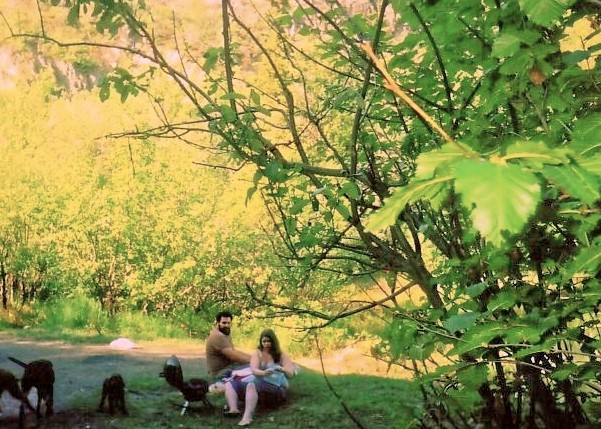
[…] This post was mentioned on Twitter by Jess Neace, Sal Pou. Sal Pou said: Metamorphosis Between the Rivers http://bit.ly/b2zMfs […]
Where is this great American spirit of invention and ingenuitiy we heard about growning up?
Why are we stuck in this carbon dependend era? Does nobody see that we are doing ourselves and our everso cherished forefathers (and mothers) a dis-service by refusing to pick up the baton and do something new and innovative.
It is our complacency and greed that will ultimately kill us off.
Very good job, Karla. I’ve never read such a knowledgeable article on rain forests and natural land. It’s a great scientific piece that also makes a great call to action. It’s a sad state of affairs the way we treat our planet, Alaska in particular. The more articles like this we have, the better chance people will start to reason and ask for a change. Of course, since most people are kept comatose watching the FOX network and buying fast food burgers, the likelihood of any change to come is minimal and depressing.
Grainne, i wonder how much is complacancy and how much is a feeling of defeat. It seems it doesn’t matter what evidence is placed in front of us, there is always the defence ready and willing to sway the jury by whatever means available. We hold the trembling seeds of the future in our hands, but we are afraid to plant them, afraid the budding sprouts will be ripped the ground before they’ve had a chance to grow.
Mitch, i agree,the madness has to stop. I’m generally an optimistic person. Even at my most cynical, i try to find those things that are precious and worth preserving. I can find nothing good to say about an idustry of thought that would continue to justify cutting open the earth and filling her with the chemicals and poisons. Now that corporate farming has given us useless fruits and vegetables witout enough nutrition to fill our daily requirements (and obnoxiously tasteless at that) they have gone a step further and propose to give us genetically modified fish and cattle as well. Is this truly the diet the American people want? A lot of transfat, steriods, hormones and trace chemicals stored into their bodies, clogging their arteries, congesting their hearts and making them candidates for the flourishing medical and pharmaceutical companies?
All these petty little differences people are quarreling about, and wouldn’t they all be happier if they were just a little bit healthier through natural instead of artificial means? That is to say, wouldn’t the practical solution be clean air, clean water and cheap energy using our natural resources? Is that worth calling an end to all other differences and working together? I feel that is should be, but then, maybe people are too addicted to their poisons to let them go.
[…] Metamorphosis Between the Rivers […]
Alaska is a place where America could get it all right .. the state should be green and no chances should be taken with a wilderness that can never be restored if destroyed by over and unnecessary development … there has to be some places that should be allowed to weather the ages as they were first found .. if support is needed from the federal government than so be it. There seems to be no end to the ideology of raping the land, no lessons ever learned, no limit on greed and corporate power … no truths that can be agreed on for all time … this was wonderful to read, your home should like a heaven on earth … although I couldn’t live in such isolation .. I would love to be able to visit a place that can remain as described here .. it would be a comfort to know that the land was allowed to win …………. for once …….
Rich, of all the gambles that have been taken in developing Alaska’s natural resources, the Pebbles proposal would probably have the worst consequences if developed, not just to our marine and wildlife, but in terms of human lives. The project is a plan to build the world’s largest open pit mine in the flanks of an active volcano. Although Iliamna doesn’t blow very often; the last time was over a hundred years ago; it has the potential to make the Krakatou explosion look like fourth of July fireworks. Added to that, Iliamna’s next door neighbor is Redoubt, an extremely active volcano that likes to remind people every ten to twenty years just what a volcanic tantrum is capable of doing. Mining is always a risky business, but when you add unstable ground, prone to earthquakes and eruptions, you’re sitting on a keg of dynamite.
The risks of oil development on the Chukchi Sea is somewhat higher than other offshore development because you’re dealing with water that is not only frigidly cold but is always turbulent. A lot of people have anxieties about the Polar Bears, but this bear is surprisingly adaptable. Northern villages have reported spotting Polar Bears far more inland than has ever before been recorded. It’s the walrus that are in the most danger. These animals are extremely shy. Pods of over one hundred animals sun-bathing on a small arctic island, have been known to panic simultaneously at the sight of a fishing boat on the horizon. Their stampede into the water leaves behind crushed calves and expectant mothers.
Our isolation does hinder a lot of people from staying, or to confining themselves to the ready-made city of Anchorage. However, it’s the climate that discourages people the most. The Cook Inlet doesn’t really get any colder than some of the northern Continental States, but our winters are longer and much darker. In the summer it rains; a lot. Our rainfalls don’t come in scattered showers. The sky clouds over and can stay that way for weeks, bringing rain in monotonous, day long drizzles. You can move farther north for the summer, but there you feel the full effects of our midnight sun, which never truly settles on the horizon for two full months but marks its path in a clear circle.
@Rich,
If you really think that the government is going to do shit to save a fragile ecosystem without some strong interest in a high-profit industry (such things fill their war chests during the campaign season), then you’re dreaming – all this talk of clean foods and water and such is nice, but the fact of the matter is that profit margins for such things are so low that one couldn’t hope to compete with the industrial giants in buying favors from Washington (which is corrupt to its very core).
If anything is going to save this ecosystem, it will be independent individuals rising up and saying “no” to industrial development and using all means at their disposal to enforce their demands (“legal” or otherwise…).